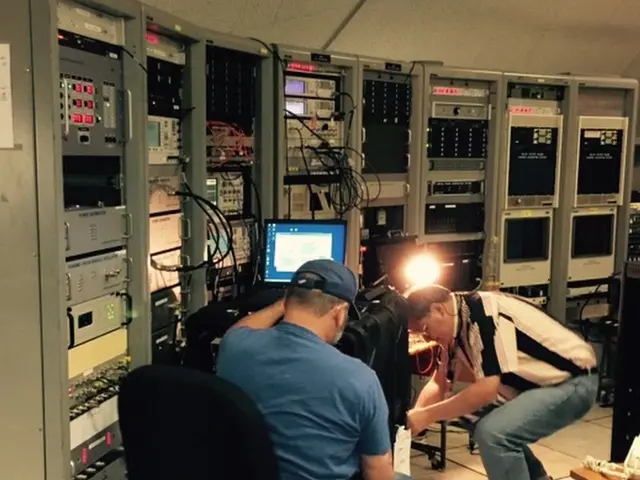Windy and Sunny Weekend: Managing Grid Stability with Renewables on Pentecost
- ~2 min read
Could there be power disruptions at Pentecost because of excessive wind and solar energy? - Power outages occurring on Pentecost due to excessive wind and solar energy production?
This weekend, grid operators expect a significant influx of wind and solar energy, raising concerns about potential power outages due to network overload. But fear not, the transmission grid operator Amprion does not foresee any grid instability, as per their response to a request from the German Press Agency, dpa.
Despite the high levels of renewable energy production, a record feed-in is not expected. Amprion, along with three other transmission grid operators in Germany, ensures the stability of the entire power system. However, the challenge lies in ensuring balance when handling solar power feed-in, particularly due to the insufficient controllability of photovoltaic (PV) systems.
The Federal Network Agency, the responsible authority, shares Amprion's optimism. The current weather conditions and the expected electricity consumption rule out any major risk of power outages over Pentecost with high certainty. The network operators have various measures at their disposal to maintain safe network operation, even under the threat of a "bright breeze"—sunny weather conditions where wind is also blowing.
Balancing the Power Grid
Maintaining a stable power grid during periods of high renewable energy generation requires a mix of technological, operational, and infrastructural measures. Here are some key strategies:
- Decentralized Power Generation: Distributed solar and wind generation helps improve grid resilience, reducing reliance on large power plants and enabling power to be generated closer to demand centers.
- Advanced Forecasting and Real-Time Management: Accurate weather and solar/wind energy output predictions allow grid operators to anticipate fluctuations and adjust generation accordingly.
- Flexible and Responsive Energy Storage: Battery storage systems, hydro storage, and emerging technologies like flow batteries and hydrogen storage enable excess energy to be stored during periods of high generation and released during times of peak demand or low generation.
- Diverse and Complementary Energy Mix: Combining wind, solar, and hydro sources helps to smooth out variability and ensure a stable power supply. Demand-side management and smart grids allow consumers to adjust consumption in response to grid needs.
- Modern Grid Infrastructure and Interconnection: Efficient transmission of large amounts of renewable energy over long distances, ultra-high voltage direct current (UHVDC) transmission lines, interconnected regional or global grids, and modern grid infrastructure help balance surpluses and deficits across different geographical areas.
By implementing these measures, grid operators can manage high feed-in from wind and solar power, prevent outages, and maintain frequency stability even as renewables become a larger share of the energy mix.
[1] - [4] Refer to the enrichment data for a detailed overview of the key strategies and current best practices for grid stability.
- The community policy should emphasize the importance of adopting renewable energy sources like wind and solar for climate change mitigation, while ensuring employment opportunities in the burgeoning industry of environmental science.
- To maintain grid stability during windy and sunny weekends, the employment policy within the energy sector should prioritize research and development in advanced forecasting and real-time energy management technologies.
- As grid operators continue to integrate more renewable energy sources into the power grid, the employment policy should focus on attracting financially savvy professionals with expertise in energy trading and investment, to optimize the financial aspects of renewable energy production.
- In order to balance the power grid's variability caused by renewable energy sources, the community policy should encourage the expansion of diverse and complementary energy sources, such as hydroelectric power and geothermal energy, as well as promoting demand-side management and smart grids.







